Murder on the Orient Express, adapted for the stage by Ken Ludwig, directed by Risa Brainin, performed at the Minneapolis Guthrie Theater
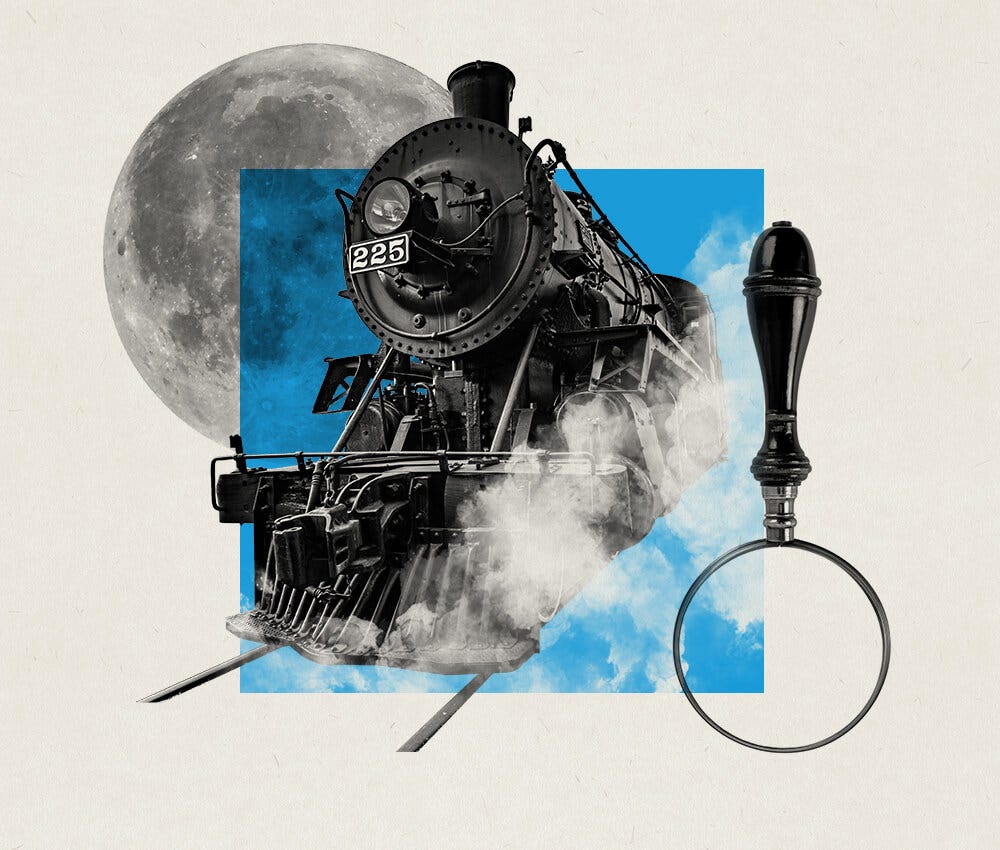 Program and advertising graphic for the show, it seems to fit the graphic design of all the show materials that are coming out this season.
Program and advertising graphic for the show, it seems to fit the graphic design of all the show materials that are coming out this season.
Ah, the theatre. I'm the type of person that spells it "Theatre" too, which is still technically correct in US English, because it got stuck in my brain in high school and never left. It's just in my muscle memory now and I'm not going to excise it anytime soon.
Anyway, I love the theatre. I had a fit last summer when I listened to 29/37 of Shakespeare's plays, not really feeling the vibe to listen to this historical plays because I don't exactly have that preexisting historical knowledge to enjoy them (they're very dry too, but that's beyond the point right now). I think live performances of all kinds are a lot of fun and can showcase how powerful the stories we tell can be.
I saw Hamlet at the same theatre the week before I came to see Murder on the Orient Express, so my Shakespeare tangent is appropriate. The Guthrie Theater is one of the greats of Minneapolis/Minnesota institutions, it's hard to ignore the building, half due to it's shape, but also because it's right on the river among a bunch of historic buildings, including the Mill City Museum (one of my favorites). I feel like every major US city has "The Theater" capital T and T, where you go to see some big productions, and that's the Guthrie for Minneapolis. There's plenty of smaller theatres in the city that I still patronize, but my housemate got our household tickets for Christmas for some shows, and as we're all big fans of stage productions in this house, we were all excited to go.
We all know this story, we know the author, we know it's a train. But not everyone knows it's ending. If you've never consumed the original book or adaptation of this story before, go do that first. For one, this play adaptation differs greatly enough that I think some original context will be missed in the content provided, but also, there's a reason this is a beloved story we adapt and retell hell over. It's just that good. Agatha Christie was just that Fucking good.
you know this story
If you're someone under the age of 100 years old and has spent any time in the western world, you probably know that Murder on the Orient Express exists and who Agatha Christie is.
For documentation's sake, Murder on the Orient Express is a detective fiction novel written by Agatha Christie that was first published on January 1st, 1934 in the UK. It was published about 2 months later in the US under the name "Murder in the Calais Coach". This was due to the novel Stamboul Train by Graham Greene originally published in 1932 in the UK had it's title changed to "Orient Express" when published in the US.
Searching "Murder in the Calais Coach" is I think different enough of a title and this is an obscure enough fact that you'll more often than not get results about "Agatha Christie's premiere Poirot novel" and vintage copies of the book, like the one below I found on ebay.
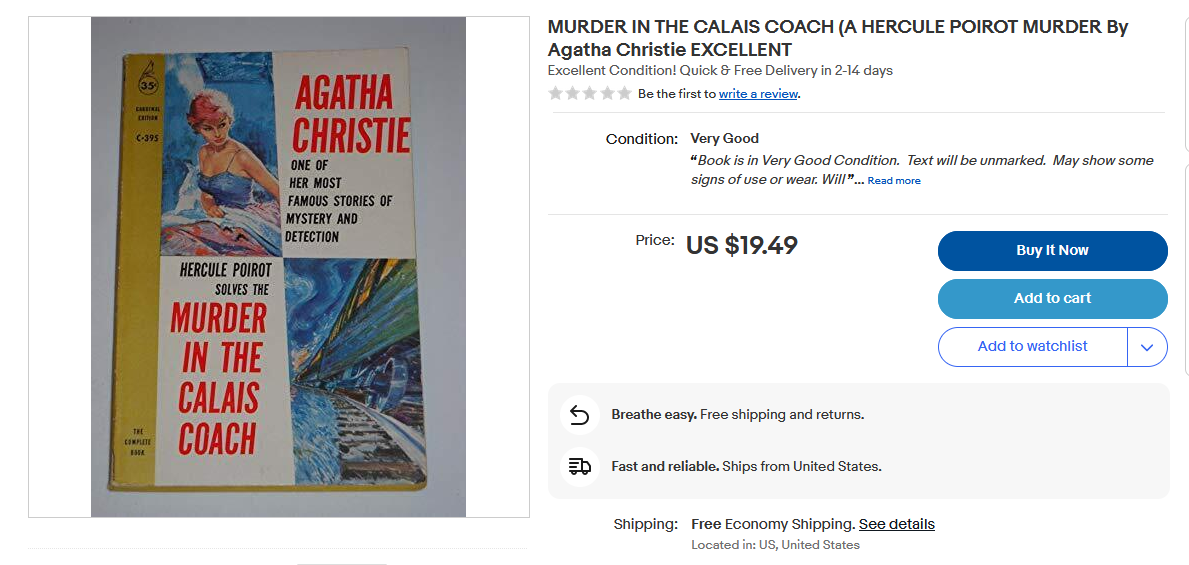 not going to lie, this would be a great collector's piece for someone like me, especially at that price.
not going to lie, this would be a great collector's piece for someone like me, especially at that price.
I'm sure that everyone is familiar with the changing of titles across country lines, a trend that I believe has died out, save for titles with direct translations for example. There is probably a more well known title change with a Christie novel, that has gone under several revised titles over time. (Which is incidentally my favorite Christie novel. for better or for worse.)
But the premise of this story is well understood, Hercule Poirot, a Belgian detective, boards the titular Orient Express, where therein a murder takes place. The case that is presented to Poirot is the most challenging that he admits to ever undertaking, not just intellectually taxing, but taxing on his very soul.
This story has been adapted a million times since the book's original publication. This particular play adaptation by Ken Ludwig was originally performed in 2017 at the McCarter Theatre in Princeton, New Jersey. (Here's a really fun video interview with the costume designer for that original show, William Ivey Long, about his work on it)
Ken Ludwig has adapted several other plays, and especially notable to me, Baskerville: A Sherlock Holmes Mystery, which is billed as comedy. I think that in that context, it makes sense for how his adaptation of the play shook out. We'll talk about that later. it's not a christie novel without a colorful cast
The original story's cast includes 17 unique characters and 12 of which are suspects in the murder of the victim. In a book format, this works for the story being told I think. 12 suspects is a lot of people to have to keep track of. If you expect to keep track of all the suspects of a mystery story, a sweet spot number is around 5-6. You can push it as high as 10, but just so long as you can cut that down pretty quickly. It's hard to have an audience keep up with all possibilities and what makes it less fun of a game/whodunnit that we love about these kinds of stories.
Christie's work does trend on having a higher amount of suspects, to heighten the drama of the story. The way that Christie deals with these high suspect counts is to make every character incredibly unique. She excels at doing this quite honestly, especially in Murder on the Orient Express. There is an even split of men and women, every character's occupation is different, their nationalities are all different, etc. You are never going to confuse a character for another because their characterization is always incredibly strong.
The play adaptation cuts the amount of characters in the story from 17 to 12, and the suspect list from 12 to 8. Like I said earlier, the less amount of suspects to keep track of during a mystery, the better. But there's a more logical reason for this too, stages are smaller than you think. If in the final scene of the show all 12 of the original characters in their original ways were present, there would be 15 people on stage at the same time. While there's no high octane action to choreograph about, 15 people is much harder to manage as opposed to the 10 that were on stage in the final scene.
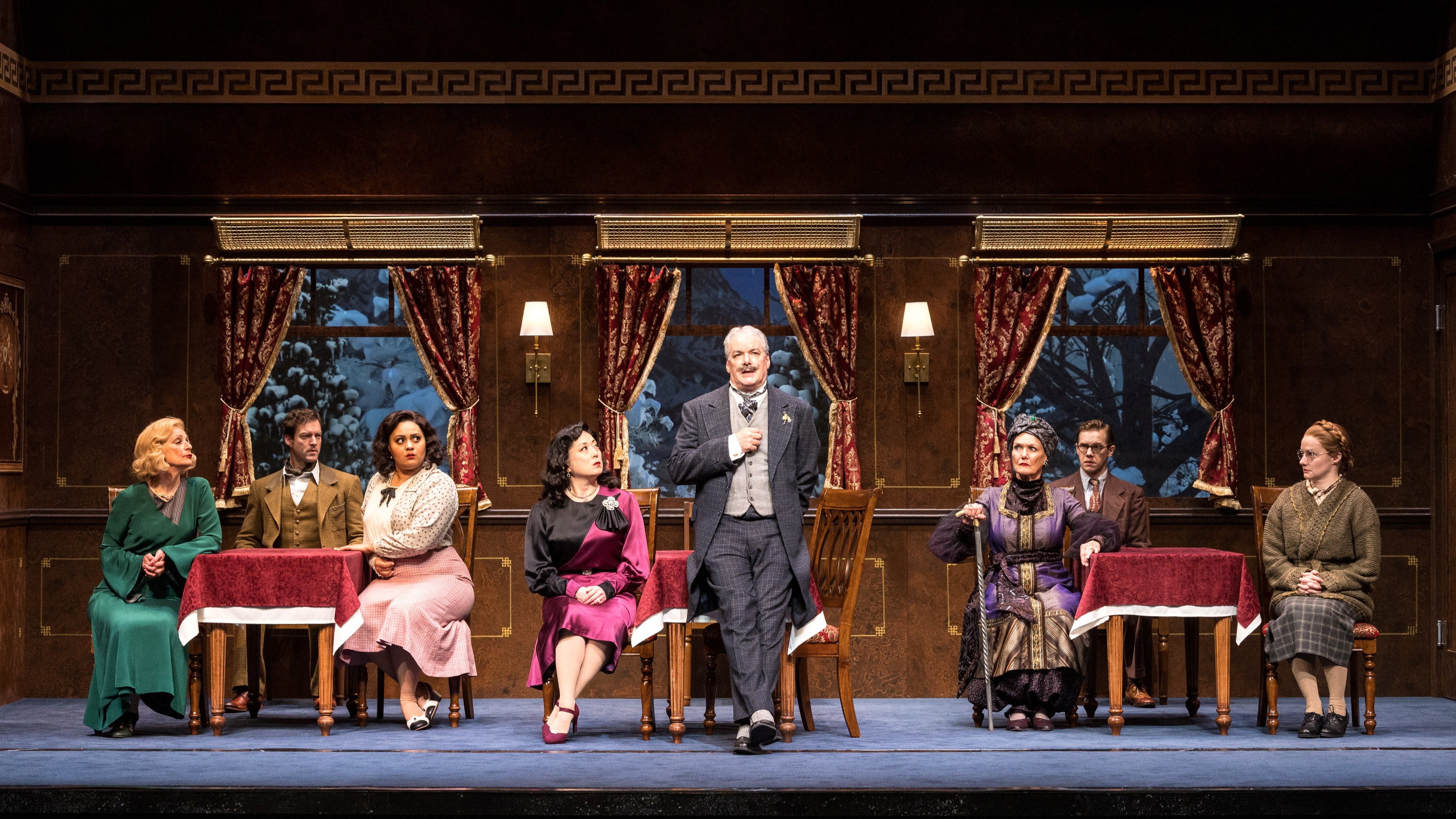 Photo by Dan Norman, from the Guthrie Theater twitter. All characters except for Michel and Bouc are seen in this image. The two of them stand off to the sides of the set, just out of this frame.
Photo by Dan Norman, from the Guthrie Theater twitter. All characters except for Michel and Bouc are seen in this image. The two of them stand off to the sides of the set, just out of this frame.
So in this adaptation, certain characters have been cut or condensed into others. They do reference the additional characters that where present in the original, however it felt like a way to satisfy those who are familiar with the original story, rather than straight up omitting their existence.
The characters of the play are as follows:
- Princess Dragomiroff, played by Michelle Barber
- Countess Adrenyi, played by Katie Bradley
- Mary Debenham, normally played by China Brickey, in my performance the role was played by Adelin Phelps
- Greta Ohlsson, played by Jane Foriland
- Colonel Arbuthnot, played by Peter Christian Hansen
- Samuel Rachett, played by Peter Christian Hansen
- Michel, played by Robert Johansen
- Monsieur Bouc, played by Gavin Lawrence
- Hercule Poirot, played by Andrew May
- Hector MacQueen, played by Tyler Michaels King
- Helen Hubbard, played by Sally Wingert
The characters that would be notably missing from this list are as follows:
- Dr. Stavros Constantine, his role as the doctor onboard the train has been added to Countess Adrenyi. She is a successful Hungarian doctor who married into royalty.
- Count Rudolph Andreny, he is mentioned as still being married to Countess Adrenyi, but played as a mere legal attachment rather than a devoted couple.
- Antonio Foscarelli, he was the Armstrong family driver, completely omitted.
- Cyrus Hardman, lover of the nurse to the Armstrong family, omitted, however the nurse's existence and suicide is still referenced.
- Hildegarde Schmidt, was the cook of the Armstrong family, talked about by Princess Dragomiroff, however only to disparage her for not being able to help her on the train. Greta Ohlsson takes over her role within the story as temporarily being the assistant/maid to the princess.
- Edward Henry Masterman, Col. Armstrong's batman during the war. His character has been omitted, with the role as Rachett's valet rolled into Hector MacQueen's role.
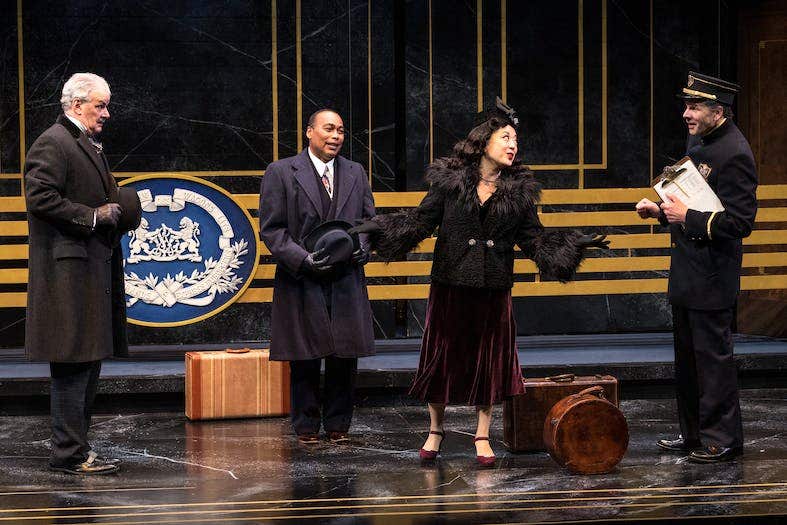 Andrew May (Hercule Poirot), Gavin Lawrence (Monsieur Bouc), Katie Bradley (Countess Andrenyi) and Robert Johansen (Michel) in the Guthrie Theater’s “Murder on the Orient Express.” Used in the Star Tribune.
Andrew May (Hercule Poirot), Gavin Lawrence (Monsieur Bouc), Katie Bradley (Countess Andrenyi) and Robert Johansen (Michel) in the Guthrie Theater’s “Murder on the Orient Express.” Used in the Star Tribune.
cutting some characters and combing them is not a bad move in my opinion. The distinctions the characters carry in the story just become more distinct with their additional aspects pulled from other characters. Countess Adrenyi as the train's doctor becomes very compelling and how her role becomes much more important to the plot than it was before, where she is portrayed as a waif and her husband acts in her stead. The nastiness of Princess Dragomiroff is toned down as she now has an irregular person as her maid/assistant, she often becomes a voice of reason and keeps a lot of the other characters grounded.
Colonel Arbuthnot in the play was changed from an Englishman to a Scotsman, for some reason, however if you look at the cast list above, you can see that Rachett and Arbuthnot were played by the same person in this production. Rachett and Arbuthnot having very distinct accents and mannerisms help give the impression that they are two different people. Rachett, the murder victim, is instead presented as a dummy in the bed when he is examined so that the actor playing Arbuthnot can be present in all further scenes.
so what about the play itself?
It's funny.
I really wasn't expecting that to be so, but there was so much comedy baked into all the character interactions it was almost slapstick in how they played out. Poirot's neuroticism that you would expect of him are toned down but the ones that are there are played for laughs. All the characters are funny too, save for Rachett for obvious reasons. But in the middle of the murder investigation, while Poirot, The Countess, and Bouc are in the same room as Rachett's dead body, me and the audience were all genuinely laughing at the lines.
This was totally unexpected. I've read the original book twice, I've watched the 2017 movie with Kenneth Branagh, I've watched the TV movie from 2010 with David Suchett, I've also watched the 1974 movie with Albert Finney except I was really drunk when I watched the version so I don't really remember it all that much and probably turned it off halfway through,
The point is, I've consumed this story A Lot. All of them are incredibly dramatic and tense, the atmosphere oppressive and suspicious. This play... wasn't that. But it wasn't a bad take on the story I think. The jokes weren't distasteful or out of line, they were always contextual to the story and helped break the tension of the situation.
The original story is incredibly dark and emotional. That aspect stays in, all the plot elements stay in as intended and are represented accurately. But the ways that the characters act, interact with each other, quip with each other, are so unique and silly sometimes you can't help but crack a smile if not laugh. It's never hysterical laughter, but the humor keeps the story bright and approachable while the past events and darker plot elements creep up around the main cast.
The humor perhaps helps make the darkness feel that much darker, the swings from high emotions of laughing at how Poirot fake laughs to disarm the people he's interviewing, to three minutes later in a dark low where the interviewee talks about how the Armstrong case caused them and the people close to them irreparable harm. You have fun, but then feel that tension in your chest as you remind yourself why they're all here.
There are moments where Poirot breaks the 4th wall and addresses the audience, with his deeper thoughts about what's going on, the inferences and connections he's making. The characters replay out the events that they witnessed, stating their lines again for the sake of the audience to illustrate the though processes and clues that Poirot is reviewing.
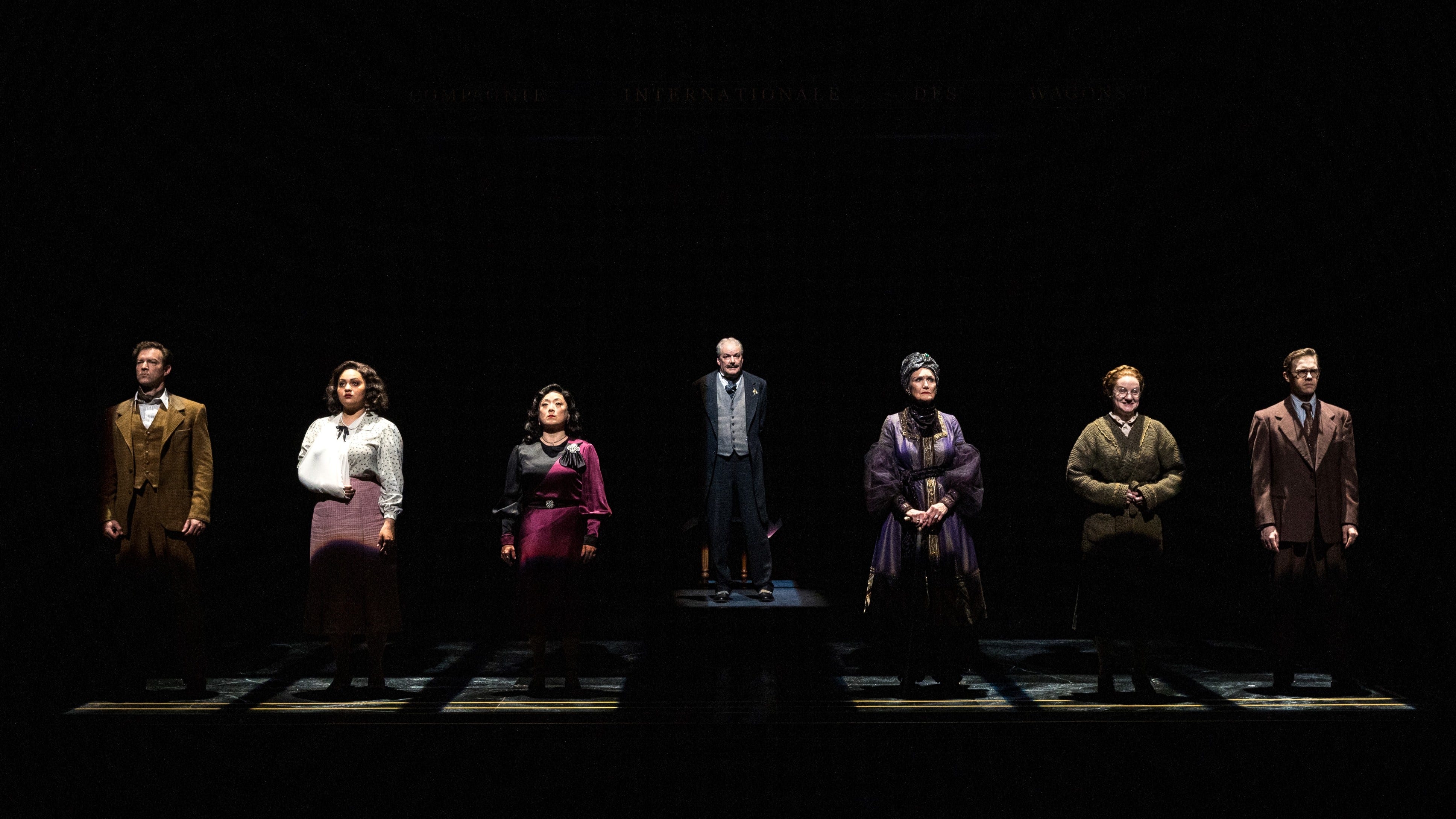 Photo by Dan Norman, from the Guthrie Theater twitter
Photo by Dan Norman, from the Guthrie Theater twitter
There is also a romantic subplot with Poirot and Countess Adreyni. Probably my favorite part of the script is in this part:
POIROT. If I asked you to leave your husband and come away with me to Monte Carlo, what would you say? COUNTESS. I would say give me five minutes, I need to pack.
Poirot never marries, though has a long homoerotic tension with Captain Hastings, his best friend from Scotland Yard, if you are consuming the stories through a queer lens. This subplot is more played for a joke than something real, but it leads to some really neat character interactions between Poirot and the Countess that I don't think have ever been explored in this way before.
It seems to be Ken Ludwig's style to add humor to tense situations, from his interview on Baskerville: a Sherlock Holmes Mystery with the Washington Post, he had this to say:
“You’re not making fun of the genre, [but] at the same time, there’s a lot of laughs, because they come out of the tension,” the playwright says.
And I feel that to be the same about Murder on the Orient Express. You're tense because there's a danger facing down all of the characters in the situations they've found themselves in, trapped on a train with a murderer, if the tension breaks because of some funny character acting, then you laugh! The man knows what he's doing.
what about the set? the sounds? the sights?
Oh budddyyyy the set!!
There is a "in front of the curtain" set that a lot of plays do, but use these beautiful painted wood panels that have images projected on them to give the impression of the scene. The behind the curtain set is very impressive. It makes up the dining car in one part, and three of the sleeping cabins. Like a train, the cars slide and move, like a train car would, moving along the train as if viewing it through a cross section. Obviously it'd mean more to see the set in person, but you can see part of in these photos:
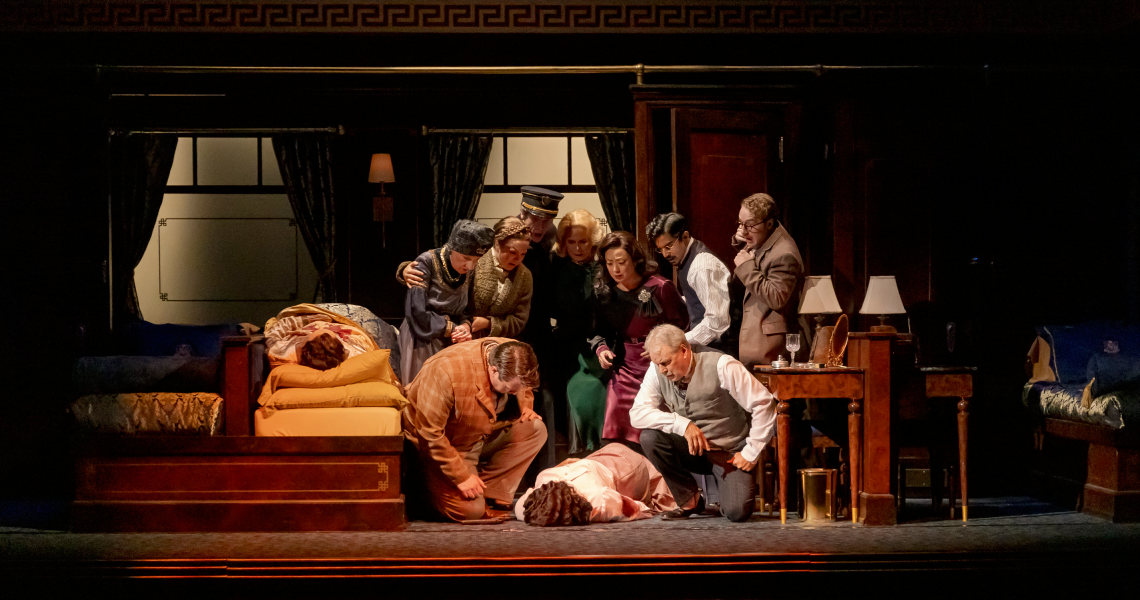
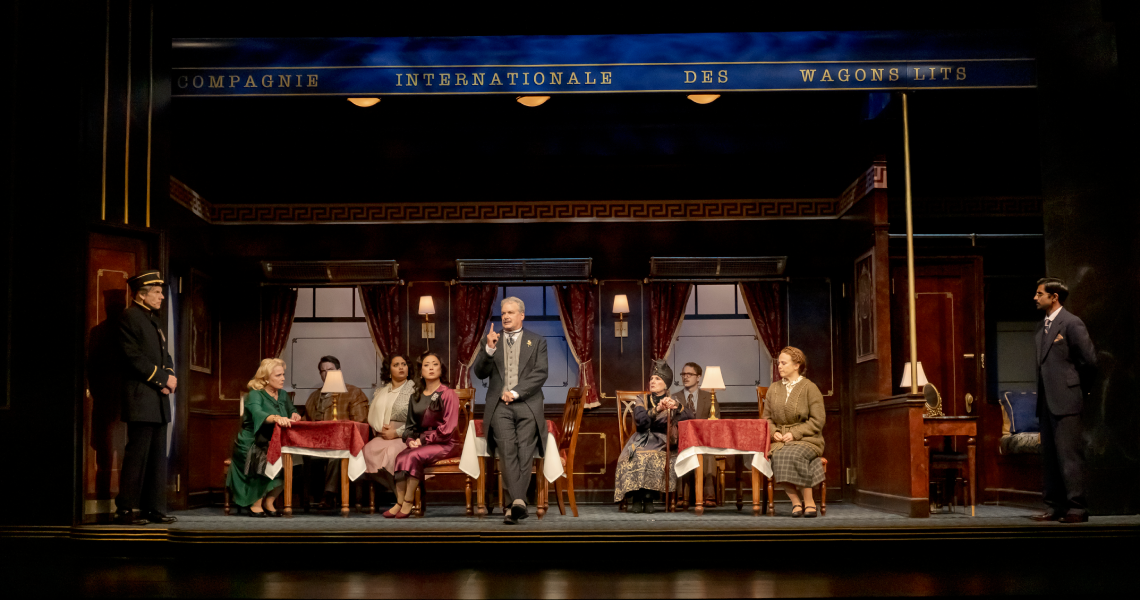 Photos from the [Cincinnati Play House production of the same show(https://cincyplay.com/productions/agatha-christies-murder-on-the-orient-express)], featuring the same set and mostly the same actors. Photo by Mikki Schaffner.
Photos from the [Cincinnati Play House production of the same show(https://cincyplay.com/productions/agatha-christies-murder-on-the-orient-express)], featuring the same set and mostly the same actors. Photo by Mikki Schaffner.
The show made use of projections and screens to help convey the extra elements of the set, such as projecting snowfall beyond the windows. The show makes good use of ambient music, sound effects of the train moving, recordings, for an experience that really does suspend the disbelief. It was minimal, but still enough to transform the story for the stage. review?
I liked it. There's a reason this story is so beloved and adapted 90 years later. While I enjoyed the humor, I think the punches felt less punchy, but when you already know the twists to the story, I think it was still very appropriate. My housemates forgot the twist at the end or had fallen asleep before the end of the movie and enjoyed the plot twist.
It's a really cool show, technically impressive, acted incredibly well, and unexpectedly funny. Ken Ludwig made some really different kinds of choices in his particular adaptation of the story and they all panned out successfully. But that's just my opinion, what do other people think?
From Broadway World (St.Paul/Minneapolis):
May utilizes every moment he has on stage (and he has a lot of it) as he truly embodies the detective that has become so etched in people's minds. Injecting moments of hilarity, only endears the audience to him more fully. As he seems to come closer and closer to revealing his suspect, May goes full out with giddiness and comedy. A far cry from the dramatic portrayal that most viewers in the audience will be familiar with by Kenneth Branagh. Rounding out the production's "leads" is the show's director, Risa Brainin who had crafted a marvelous night at the theater. It is not an easy feat, to direct a show that has hundreds of moving pieces and she has done a sublime job.
The cast clearly is having fun and standouts include Bradley as the curt and professionally courteous countess, Froiland as the overdone Greta and Wingert as the loud, bawdy and unabashedly Minnesotan Helen Hubbard. Kudos also to Hansen, for showing range in his dual roles as the Scottish colonel and the deserving murderee, to Lawrence as the benevolent caretaker and to Barber as the grand princess. "Murder" answers a question that gets asked from time to time: How can you make entertainment about murder when, in the real world, events around such crimes bring such heartbreak? That's because the world in this "Murder" is ridiculously self-contained and the characters are over-the-top. And as all the clues of this whodunit become a puzzle, your mind gets locked into solving it, thereby offering an escape on a throwback train journey.
so what now?
Well, the show is still ongoing and if you're in the Minneapolis area and will be here at the Guthrie from May 13 - July 2, 2023. This play is likely being performed in other places too and if it's in your area, I recommend seeing it if you can!
Also, if you'd like to put on the show yourself, you can also order the script or request a license to put on the show yourself if you like via Ken Ludwig's website.
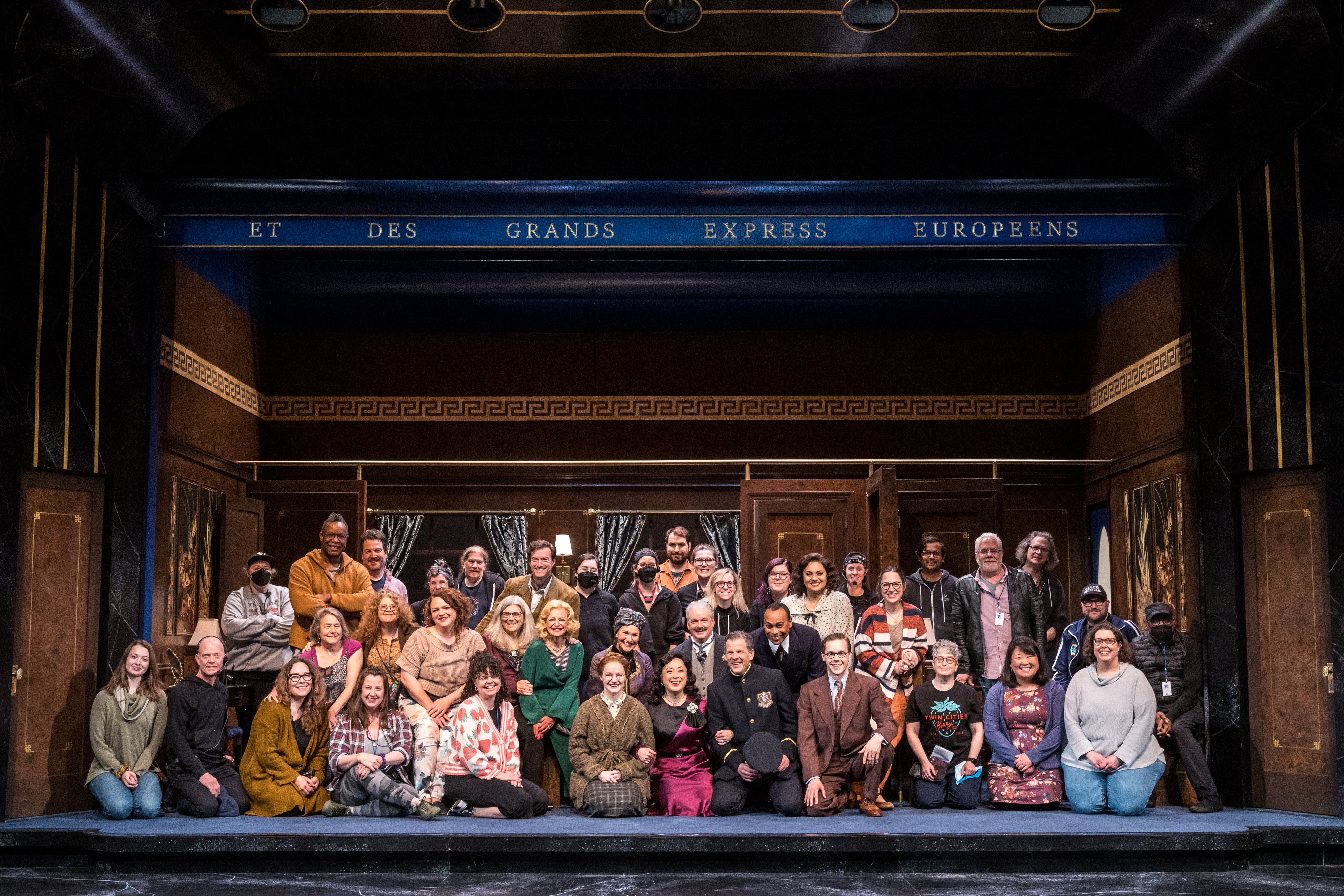 From the Guthrie Theater twitter
From the Guthrie Theater twitter
There's something I never really intentionally considered trying to do with mystery my own mystery stories is try to make them funny. I enjoy writing comedy into all of my stories, but I never thought about them in depth as a tool to control how the audience feels and lead them along the journey of the story. Being able to witness this play performed was a really good experience for things to think about in my own work going forward.
I probably won't want to write plays, I think I'm not that good at visualizing how people move around a stage, but I might pick up a copy of the play to just do a fun table read with my friends in the future.